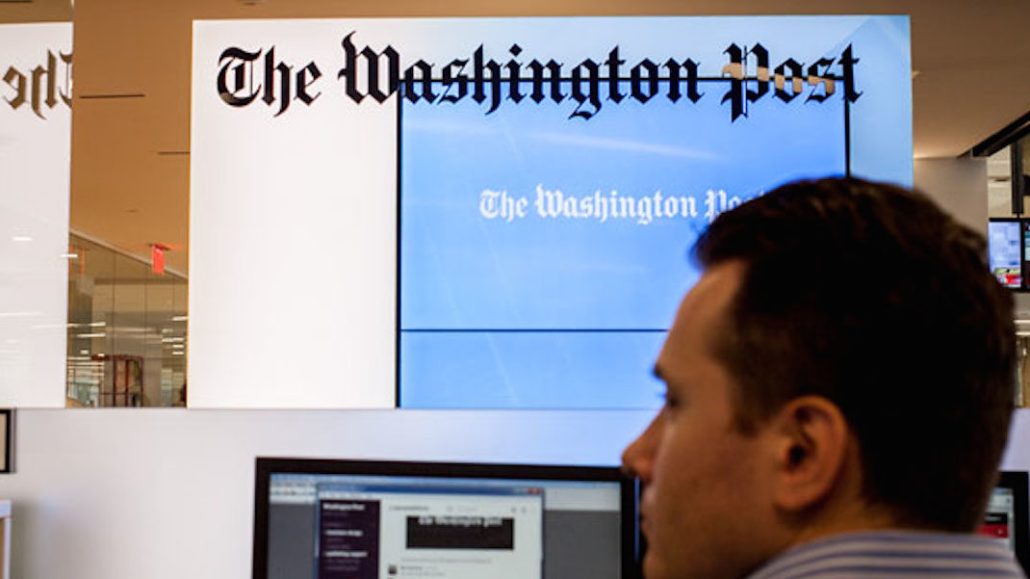
The Washington Post plans to use augmented reality to enhance its reporting and storytelling in 2017.
The Post first used AR last year to explain the events that led up to Freddie Gray’s arrest death in Baltimore in 2015. But people had to download an app to access the experience. Since then, the Post has been building an AR framework into its two existing apps — its magazine-style “Rainbow” app and its more traditional, newspaper-style app — to take friction out of the process.
It plans to launch its first AR story this spring, and then one per quarter. The first will be for a series by its art and architecture critic Philip Kennicott that will examine new, innovative buildings. AR will be used to let people look around the interiors and listen to narration using their smartphones.
Virtual reality and its lower-tech cousin, 360-degree video, got a lot of attention from publishers last year. But VR is expensive to do, there aren’t a ton of viewing devices in use and the use case isn’t always clear to editorial. Then there’s the trick of convincing the advertisers who’d be helping to pay for it all.
It can be easier to scale AR, which involves inserting digital elements into real world representations, the best known example being the Pokémon Go game.
“‘We’re still very skeptical around AR as well,” said Joey Marburger, director of product at the Post, who’s spearheading the project. “But the tech has gotten a little better with these frameworks being available, lighter assets, things like that. With VR, you have to have a headset. Everyone’s got an AR-capable device in their pocket. There’s potential scale there.”
It’s not necessarily cheap. Outside the Post, media companies are just starting to experiment with AR. The New York Times had long been interested in AR, but it took having a sponsor to really try it out. The result was a project that its branded content arm, T Brand Studio, launched in January with IBM called “Outthink Hidden,” inspired by the movie “Hidden Figures.” USA Today, which has been a heavy adopter of VR, said it’s experimenting with AR but didn’t have any details to share.
The Post’s deep-pocketed owner Jeff Bezos has given it the runway to experiment heavily. The Post does have a sponsor lined up for its first AR story. (Marburger wasn’t authorized to say who it was, but said the ad would take the form of elements served in between and within the story but clearly identified as an ad.)
Katie Emery, director of global marketing solutions at the Post, said there’s been a lot more interest among advertisers in AR since Pokémon Go took off, and that many already have AR assets or ideas about how to use it. She said she’s talked to one that was interested in using AR to show their product from all sides and another that wanted to use it to show the inside of its retail locations. “Advertisers are more likely to know what to do” with AR versus VR,” she said.
But the Post can do AR inexpensively enough so that it doesn’t depend on having a sponsorship, Marburger said. A lot of the prep work had already been done, for earlier editorial projects, so it’s not like the Post has to start from scratch. As for the human resources, the Post has dedicated a couple of people from the news side to focus on new forms of storytelling, including AR. There are also two engineers and a product manager who are spending most of their time working on the AR stories.
AR isn’t without its challenges, though. It’s still a new experience for most people, so they have to be trained to use it. A lot of the Post’s work involved creating prompts to guide people through the AR elements of the story (and let them skip to the text version if they want).
AR also doesn’t lend itself to every story. To Marburger, the ideal one relies heavily on visuals so AR can show what the story is describing; has a long shelf life; and has options for people to explore. But by doing these projects, the Post hopes to have some experience under its belt if and when AR becomes more widespread, as well as apply what it learns to future VR projects.
“We haven’t bet the farm on it, but we want to learn from it,” Marburger said. “Worst case, we come out of it better storytellers.”
More in Media

From sidelines to spotlight: Esports events are putting creators center stage
Esports events’ embrace of content creators reflects advertisers’ changing priorities across both gaming and the wider culture. In the past, marketers viewed esports as one of the best ways to reach gamers. In 2025, brands are instead prioritizing creators in their outreach to audiences across demographics and interest areas, including gaming.

Condé Nast and Hearst strike Amazon AI licensing deals for Rufus
Condé Nast and Hearst have joined the New York Times in signing a licensing deal with Amazon for its AI-powered shopping assistant Rufus.

Media Briefing: AI payouts may be entering a new era
AI compensation is evolving — and new models, not just publisher demands, are driving the shift beyond flat-fee licensing.








